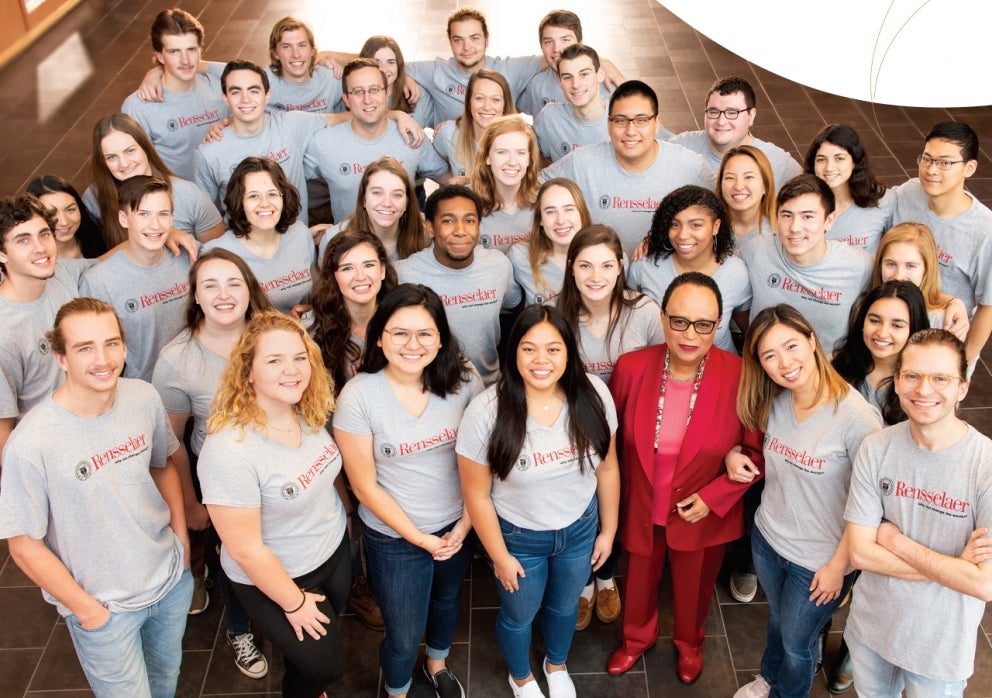
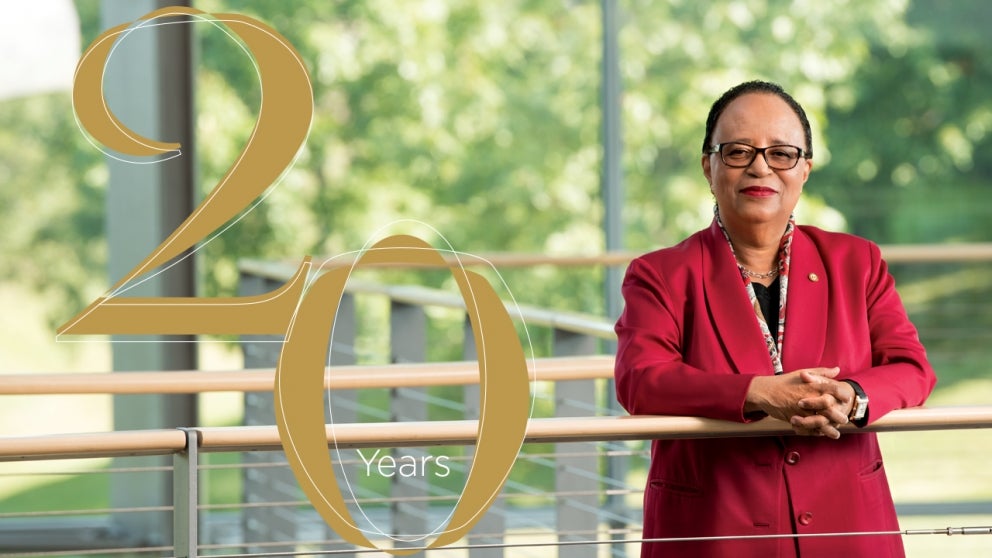
A Celebration of Leadership
Over the last two decades, under the leadership of President Shirley Ann Jackson, Rensselaer has been transformed into a world-class university with global reach and global impact.
By Jane Gottlieb
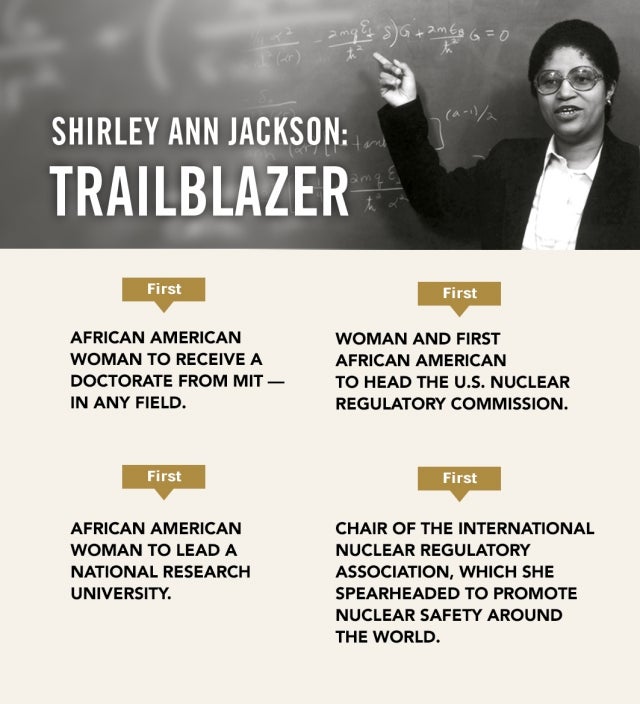
Twenty-one years ago, a half-dozen people interviewed to be the 18th president of Rensselaer Polytechnic Institute. Among the candidates, including a college president, was Shirley Ann Jackson, an accomplished theoretical physicist and head of the Nuclear Regulatory Commission.
“She was not in the least pushy or salesman-like. She was quite the opposite — thoughtful and somewhat reserved,” recalls Gary DiCamillo ’73, a trustee involved in the search. “Some people come on strong and fast. With her, you almost wanted to know more.”
DiCamillo, a trustee for the past 23 years, had majored in chemical engineering at Rensselaer and gained skills he applied to become chair and CEO of Polaroid and now president and CEO of Universal Trailer Corporation and managing partner at Eaglepoint Advisors, LLC.
Like many people he knew, he was proud of Rensselaer’s legacy of graduates who had built many of the world’s great railroads, bridges, and dams. He and others also saw the need for new energy.
“RPI was living on its prior reputation,” he says. “The board of trustees viewed this as an opportunity for change and growth.”
As the search committee considered who would lead Rensselaer to its next, critical chapter, the MIT-educated Jackson stood out for her intellect and vast knowledge of technology. The first African American woman to earn a doctorate in any field from MIT, she has held appointments by two United States presidents. A one-time colleague who knew Jackson well from her federal policy work offered this input:
“He said we’d be stupid to miss an opportunity to hire Shirley Ann Jackson. She is well regarded, solid, a real rock star if you will,” DiCamillo recalls. “He said ‘let me assure you she is the best person for the job.’ And he was a person you listen to.”
The assessment was spot on. At her September 1999 inauguration, Jackson vowed to elevate Rensselaer to a top-tier technological research university. Within the year, the board approved The Rensselaer Plan, Jackson’s dynamic and detail-laden document that laid out steps for moving the school into the next century.
Plans quickly turned into action, as the school broke ground for new highly advanced facilities, or renovated existing spaces, dedicated to the study of biotechnology, nanoscience, design prototyping, advanced computing, and media arts. Within five years, research awards had more than doubled to $80 million. Within 10 years, the campus was home to world-class facilities including the Center for Biotechnology and Interdisciplinary Studies, the Curtis R. Priem Experimental Media and Performing Arts Center, the Center for Computational Innovations, and the East Campus Athletic Village.
And today, 20 years later, Jackson has done nothing short of transforming Rensselaer from a reputable and rigorous technical institute into a comprehensive research university devoted to global challenges.
During her tenure, Rensselaer has added 24 degree programs, hired 384 new tenured or tenure-track faculty members, and dedicated itself to educating undergraduate and graduate students to envision the big picture as they learn the most advanced tools of technology.
“You have the admissions story. It’s incredible. We now get over 20,000 applications a year. Our freshman class is over 1,700. In my year it was about 1,000,” says DiCamillo. “We have higher quality students with higher SAT scores, who are more diverse, and a much healthier campus. We have better academics, better research, better arts. The dorms are better, the physical plant is better, even the food is better. And financially, we’re much better off. We’re investing in more professors, more research. President Jackson is the proverbial ‘energizer bunny.’ ”

Emboldened By Her Background

In 2016, President Obama awarded Jackson the National Medal of Science, the government’s highest honor in the field. At a springtime ceremony at the White House, he cited her contributions to condensed matter and particle physics. He went further:
“Over the years, Dr. Jackson has revolutionized the way science informs public policy, from rethinking safety at our nuclear plants to training a new generation of scientists and engineers that looks more like the diverse and inclusive America she loves.”
Under Obama, Jackson co-chaired the President’s Intelligence Advisory Board, which assesses how effectively federal agencies collect intelligence. She served on the President’s Council of Advisors on Science and Technology. Under President Clinton, she chaired the Nuclear Regulatory Commission, which licenses and safeguards nuclear reactor byproducts. Among other things, she put the agency on a more businesslike footing through planning and budgeting to make the plants safer.
She has also served on the U.S. Secretary of State’s International Security Advisory Board, the U.S. Secretary of Energy Advisory Board, and the U.S. Comptroller-General’s Advisory Committee for the Government Accountability Office. In addition, she was a member of the National Commission for the Review of the Research and Development Programs of the United States Intelligence Community, the Advisory Committee for the U.S. Department of Energy’s National Nuclear Security Administration, and the National Advisory Council for Biomedical Imaging and Bioengineering of the National Institutes of Health. She co-chaired the Council’s Energy Security, Sustainability, and Innovation initiative.
Before Jackson came to the attention of American presidents, and global corporations invited her onto their boards, she distinguished herself in research.
At the Fermi National Accelerator Laboratory, she studied medium to large subatomic particles. Turning her attention to solid state physics, she joined Bell Laboratories in 1976. There, Jackson researched materials used in semiconductors and eventually wrote or collaborated on 100 scientific articles. Her research specialty was in condensed matter physics, especially layered systems, and the physics of opto-electronic materials. She remained a consultant there after joining the Rutgers University faculty to lead a research team in theoretical physics.
Often, Jackson was the first or only African American woman in these posts. Invoking what she calls her “stubborn focus on excellence,” she chose early on to view difficult experiences as opportunities for change.
“Dr. Jackson faced those who belittled and resisted change with dignity, grace, and a relentless diligence,” notes Wanda Denson-Low ’78, J.D., a former Boeing executive who is vice chair of the Rensselaer Board of Trustees. “She saw these obstacles as a challenge to overcome and hoped her work would speak for itself. It did.”


Jackson was born in segregated Washington, D.C. Her parents encouraged her early interest in math and science. Two historic events determined her educational path. The first, the U.S. Supreme Court’s 1954 Brown v. Board of Education decision, allowed her to attend an integrated public school and follow an accelerated honors track. The second, the Russian launch of Sputnik, sparked national enthusiasm for science and math education.
She graduated as valedictorian of Roosevelt High School and went on to pursue physics at MIT. In 1973, Jackson earned her doctorate in theoretical elementary particle physics, devoting her dissertation to a new way to model complex decisions. By then she had also laid the foundation for a more inclusive MIT. She helped start the school’s Black Students’ Union, which called on the administration to ramp up recruitment of minority students and support them financially and improve their lives at the university, as well as add minority faculty members.
The school established the Task Force on Educational Opportunity and invited Jackson to join. She traveled the country to recruit minority students. After one year, 57 African American freshmen enrolled, significantly more than the usual three to five. On top of that, Jackson helped create, and taught in, a summer program providing academic support.
“Not many alumni can see the mark of their leadership on an institution 50 years after they graduate. At MIT, Dr. Jackson is one of those rare few,” says the president of MIT, L. Rafael Reif. “A co-founder of the Institute’s Black Students’ Union, she has always had a knack for bringing people together around shared values.
“As deeply as I admire the role she has played in elevating RPI into a pre-eminent research institution, her success doesn’t surprise me one bit,” Reif adds. “Both MIT and RPI have benefited immeasurably from her brilliance, her vision, her leadership, and her extraordinary commitment to inclusive excellence.”


Sticking to the Plan

As soon as Jackson took the helm in July 1999, Rensselaer began evolving from its identity as a renowned engineering school where other disciplines largely played a supporting role. The institution moved toward becoming a world-class technological research university devoted to the sciences, social sciences, arts, humanities, architecture, and business — along with top-notch engineering.
But Rensselaer would go well beyond adding programs. It would help students build global awareness and think outside the confines of their disciplines. Those who discovered they did not wish to pursue engineering after all could explore a multitude of other academic avenues.
“We wanted to produce leaders for this next generation and to do that, their thinking had to be broadened so they could view the world differently,” says Provost Prabhat Hajela, who came to Rensselaer 30 years ago as a professor of aerospace engineering. “We needed to strengthen programs across the school, and we did.”
The blueprint, Jackson’s May 2000 Rensselaer Plan, touched on just about every aspect of the then 176-year-old institution. Its narrative vowed “We Will” more than 140 times, addressing everything from research and pedagogy, to student life and the face of the campus.
True to form, the new president backed the goals up with timelines, budgets, and details. In just a few years, students came to Rensselaer to study in fields such as biotechnology, nanotechnology, computer science, and game development.
Accomplished new professors brought a fresh take on leveraging technology to improve manufacturing, health care, the environment, and the economy. No one who witnessed the early steps would describe them as subtle.
“The vision and goals that President Jackson set for RPI were extremely challenging. They had to be in order to return Rensselaer to our leadership position in the world,” notes IBM Executive Vice President John Kelly III, ’78G, Ph.D. ’80, a Rensselaer trustee. “Pursuing and achieving these goals in a higher education environment presented many obstacles. Fortunately, she and her team have no fear, and charged ahead, making amazing progress.”
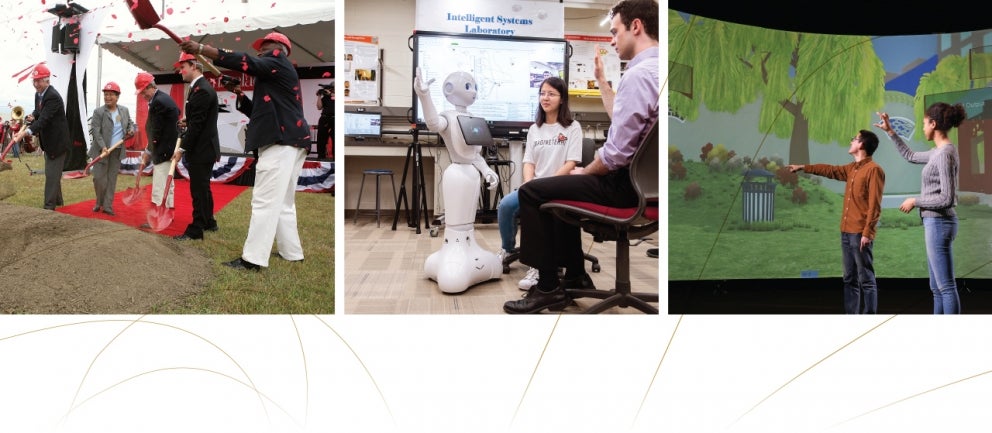

When Jackson arrived in 1999, she used input from students, faculty, administrators, staff, alumni, parents, local residents, business owners, and industry leaders to assess the institution’s strengths and weaknesses. She identified philosophical priorities and five signature research thrusts to help Rensselaer meet 21st-century challenges. These were Biotechnology and the Life Sciences; Computational Science and Engineering; Media, Arts, Science, and Technology; Energy, Environment, and Smart Systems; and Nanotechnology and Advanced Materials.
Hajela says an early focus was on developing the sciences — without which an engineering school could not be vibrant — and building a biotechnology program, without which innovation would not have been possible.
“You’re skeptical whenever a strategic plan is drafted. The history is that they are discussed and then put on a shelf,” he recalls. “That did not happen here. We were really going after those ‘We Will’ statements. There was change and there was angst as well. There was a great deal of anticipation.”
It didn’t take long for the campus to reflect the momentum. In May 2002, Rensselaer broke ground on the 218,000-square-foot Center for Biotechnology and Interdisciplinary Studies. Spurred by the enthusiasm of donors, including an anonymous $360 million unrestricted gift, the portfolio of programs and facilities continued to grow. This included the O.T. Swanson Multidisciplinary Design Laboratory in 2000, the Center for Computational Innovations in 2007, the Curtis R. Priem Experimental Media and Performing Arts Center in 2008, and the East Campus Athletic Village in 2009. In addition to the new buildings and platforms, Rensselaer made updates and renovations to revitalize the historic campus.
There have also been plenty of advances that are less visible. Under Jackson’s leadership, computing and analytics were integrated into the curriculum. An Art_X curriculum allowed students to explore the intersection of science and art. Other classes brought together technology and music. “She reinvigorated disciplines like aerospace engineering, created a curriculum on gaming, one of the first in the country. She established an M.S. in business analytics before analytics had become a household name in STEM disciplines,” Trustee Denson-Low says. “She ensured by changing the curriculum that all students would learn how to code in response to changes happening in industry.”
To bring professors in different disciplines together, Jackson introduced research constellations, endowed professorships devoted to a highly specialized interest. Today, constellations include biocatalysis and metabolic engineering, biocomputation and bioinformatics, and functional tissue engineering and regenerative medicine. Each includes faculty, students, and postdoctoral scientists.
Graduate studies also blur lines between disciplines. Graduate students work in centers that examine such areas as integrated electronics, composite materials, design, robotics, and scientific computation.
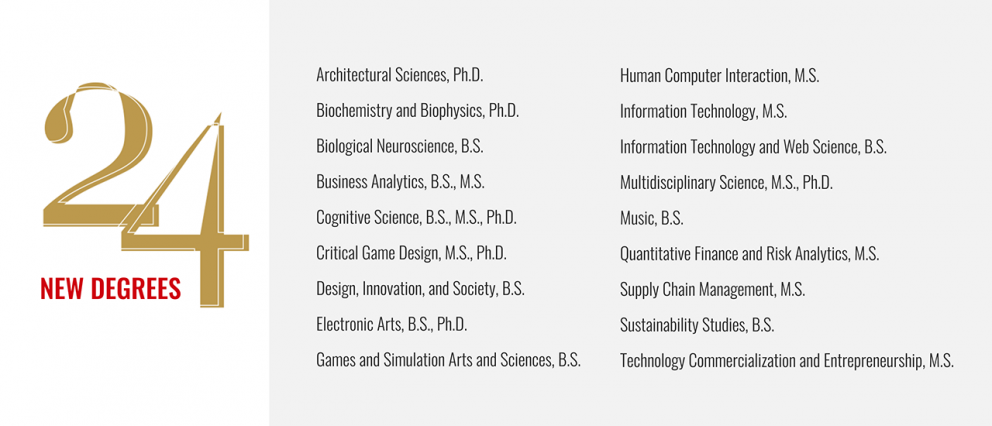


Sponsored research has risen dramatically since The Rensselaer Plan launched. Research opportunities permeate a Rensselaer education, from significant grants from the National Science Foundation, General Electric, or the U.S. Department of Defense, to semester-long class projects that put theory into practice. Many alumni who follow the school’s story see Rensselaer becoming what it was intended to be.
“When I return to campus, I see the full potential of RPI blooming, particularly in our students,” says Kelly. “The new platforms provide the foundation for our extraordinary faculty to help every student achieve their full potential.”
“I don’t think any alum, or anyone else with prior knowledge of RPI, can walk the current campus without appreciating the enormous improvements and rejuvenation of the physical RPI,” says Arthur Golden ’66, J.D., chair of the Rensselaer Board of Trustees. “EMPAC, the Biotech Center, and ECAV are new and spectacular and blend beautifully with the refreshed parts of the old campus — a refreshment process that is continuing apace. The combination provides the basis for a great environment for students and faculty, and a great attraction for recruiting new students and faculty.”
The Rensselaer Plan and its subsequent Rensselaer Plan 2024 emphasize ties from the classroom to the community and world beyond.
“I’ve noticed that students are coming in with a much greater social awareness than ever before,” notes Hajela. “They want to see what they can do to change the world. We help them find outlets for doing that.”
As Rensselaer progresses, students are steeped in professional experiences on and off campus. It is not unusual for them to graduate with more than one internship at NASA, General Electric, Procter & Gamble, or other leading corporations or government agencies. Often, they find they hold their own with experienced professionals.
Rensselaer senior Caitlin Kennedy, for example, had already done an internship with the U.S. Naval Shipyard the summer after her junior year when she embarked on an internship with Procter & Gamble the following summer. Her tasks went from working on the refueling team for the reactors in the submarines, to finding efficiencies in manufacturing disposable diapers.
“RPI is very challenging. I don’t think anyone denies that,” says Kennedy, who is pursuing a double major in mechanical engineering and economics while also serving as president of the Student Union. “But it also gives you real-world experience and hands-on opportunities that you wouldn’t necessarily have someplace else. I feel very confident going for these internships and tackling these projects.”
Companies looking for solutions in advanced manufacturing, computing, and medicine also come to campus. They sponsor students and faculty who are fine-tuning robotics and shaving off time and materials used in manufacturing.
Rensselaer is home to an IBM supercomputer — among the world’s fastest — the Advanced Multiprocessing Optimized System. It is the first university with an IBM Watson system, made famous by its victory over top human contenders on Jeopardy! Another IBM partnership, The Jefferson Project at Lake George, uses technology to examine the human impact on fresh water. That work, which also involves the FUND for Lake George, is located along the lake at the Rensselaer Darrin Fresh Water Institute. Collectively, these experiences equip students to handle professional challenges before they graduate, and make them sought after once they do.
“IBM’s partnerships with universities like RPI are successful because we share a clear sense of purpose and a commitment to education,” says Ginni Rometty, the chair, president, and CEO of IBM, who enjoys a close collaboration with Rensselaer and received an honorary degree in 2014.
“Together, we have advanced artificial intelligence, nanotechnology, high-performance computing, and other disciplines,” she adds. “But, just as important, we’ve created a pipeline of remarkable talent that will benefit industry for years to come.”
Change Agent
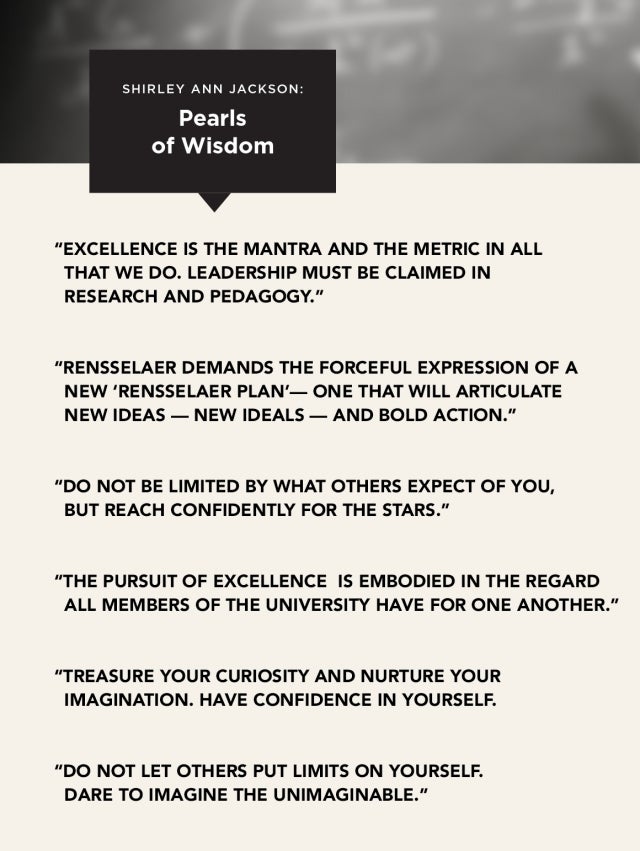
As she leads the university in Troy, Jackson also makes an imprint worldwide through public service and input on corporate and nonprofit boards, as well as a host of professional and fraternal organizations.
“Dr. Jackson’s counsel and mentorship have been invaluable to me, especially as I’ve worked to extend IBM’s decades-long leadership as an inclusive company,” says IBM’s Rometty. “She knows from experience that inclusive organizations are stronger, more responsive, and more innovative.” Jackson, Rometty notes, has been instrumental in paving the way for women.
“Most recently, under her leadership of IBM’s corporate governance committee, we added two incredibly accomplished women to the IBM Board: Dr. Martha Pollack, president of Cornell University and a leading researcher in artificial intelligence, and Admiral Michelle Howard, the U.S. Navy’s first female four-star admiral and the first African American and first woman to be named Vice Chief of Naval Operations,” she says.
In addition to IBM, Jackson serves on the boards of FedEx Corporation and PSEG. She was a member of the board of governors of the Financial Industry Regulatory Authority, the board of directors of NYSE Euronext and its predecessors, and chairman of the board of NYSE Regulation. She has served on numerous other public company boards.
The Nature Conservancy recently appointed Jackson to its global Board of Directors.
“Achieving our mission in the face of today’s complex environmental challenges will take world-class science, innovation, and collaboration,” says Thomas J. Tierney, the Nature Conservancy’s board chair. “We look forward to drawing on Dr. Jackson’s deep expertise in these areas and know that she will make a tremendous contribution to our efforts to tackle climate change, protect important lands and waters, provide food and water sustainably, and build healthier cities.”
Jackson has also used her position to make enormous contributions close to home. From 2000 to 2015, Rensselaer spent more than $7 million to improve infrastructure in Troy, including housing for its own students.
Rensselaer was a driving force behind the Hilton Garden Inn just north of campus on Hoosick Street; and the City Station graduate housing on Congress Street. Rensselaer purchased and helped refurbish the historic Chasan Building and adjacent former Proctor’s Theater in the heart of downtown, which now house several offices and departments. Human Resources and the architecture program’s renowned Lighting Research Center are located in the historic Gurley Building. Students, staff, and alumni play a big part in contributing to the city’s economy.
“Once it felt like RPI was the big university on the hill,” says Troy Mayor Patrick Madden. “Today, it is largely part of the city — students, faculty, and staff play a vital role here. From filling our stores and restaurants, to living and working in the city, they are investing in our future.
“Whether it’s their groundbreaking research institutes, nationally recognized student athletes, or the institution’s overall commitment to academic excellence, the national stature of RPI is a source of pride for the Collar City,” Madden continues. “The school’s tremendous transformation during the last two decades has brought positive change to our community, a benefit that continues to ripple throughout our city and the Capital Region.”
The United Way of the Greater Capital Region recently named Jackson and her husband, Morris Washington, to its Philanthropy Hall of Fame, in recognition of their commitment to the community.
“President Jackson has been one of the strongest regional partners for our efforts at United Way. She understands the issues and challenges, but her willingness to get involved in the solutions is what makes her leadership truly remarkable,” says Peter Gannon ’11, president and CEO.
Jackson has also put her efforts toward higher education and cultural organizations. She is former vice chair of the Board of Regents of the Smithsonian Institution, a trustee of the Brookings Institution, a former member of the board of the Council on Foreign Relations, and a former member of the board of the World Economic Forum USA.
She remains closely aligned with MIT, as life member of the MIT Corporation (the MIT Board of Trustees). Lawrence Bacow, a fellow MIT alum and now president of Harvard, recalls the response she got when they appeared at an event marking the 50th anniversary of the group Blacks at MIT.
“The auditorium was packed with loyal and incredibly accomplished alumni of MIT. It was clear from the warm reception that she received from this group that they believed they owed much to Shirley’s efforts as both a student and then subsequently, as a life member of the MIT Corporation,” says Bacow. “Shirley is someone who is not afraid to say what she thinks and to also act on her beliefs.”
Others she serves with also see Jackson’s personal story play out in her civic commitment. Among them is Lonnie Bunch, secretary of the Smithsonian Institution.
“Dr. Jackson’s service on the Smithsonian Board of Regents was nothing short of transformational,” he says. “Her support and guidance were instrumental to the successful opening of the National Museum of African American History and Culture in 2016, a day that was made better by Dr. Jackson’s personal reflections on growing up in segregated Washington, D.C. All of us at the Smithsonian were made better by her presence, skills, and dedication.”


Focus on Student Life

On any given night the playing fields in and around the East Campus Athletic Village are lit up and loud as students play soccer, lacrosse, cricket, and kickball.
Thousands take part in club and intramural athletics, use the fitness center and rock climbing wall, and go on rafting and ski trips. Rensselaer students have 200 clubs to choose from. “I think many of our students find their passion and home within one of the over 200 clubs housed within the Union,” says Kennedy, the 130th president of the Union. “Many of these clubs partner with different academic departments which the administration helps with.”
On top of its long list of achievements, The Rensselaer Plan has fulfilled ambitious goals for elevating student life. In addition to encouraging wellness, recreation, and hobbies, the initiatives support students during their transition from high school and at every point after.
The umbrella for many of these efforts is CLASS — for Clustered Learning, Advocacy, and Support for Students. Jackson created CLASS to build in supports and activities that connect students to faculty, staff, and other students to help them adapt to campus life and excel. Networks of deans and counselors play a role. There are enhanced orientations and activities that bring students together with faculty. CLASS builds in opportunities, from the First-Year Experience through graduate and doctoral work.
Now, Rensselaer has introduced The Arch, which requires students to remain on campus the summer after their sophomore year to take junior-level classes — with the focused attention of their professors. They then leave campus for a semester to pursue a co-op, internship, service work, or an international experience.
“The Arch will, I believe, become known as a great academic and life-preparing accomplishment,” says Board Chairman Golden. “It will facilitate a changed and improved method of learning and prepare students better and afford them greater opportunities as they prepare for their lives after RPI.”
There are those who are perplexed by a program that essentially rewrites the academic calendar, he acknowledges. But Golden believes that as unique as the concept is, like many ideas Shirley Ann Jackson implemented in the past 20 years, The Arch will one day become a seamless part of the Rensselaer experience.
“Great ideas are always obvious after someone else has thought of them — and the risks seem small after they have been successfully dealt with,” he says. “These examples demonstrate the true entrepreneurial spirit that we try to instill in our students.
“President Jackson’s numerous personal achievements have made RPI’s star shine brighter,” Golden says. “To simply state the obvious — we are in a much better place because of her than we were 20 years ago.”
